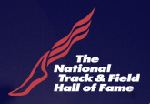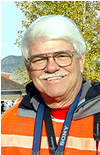|
the National Track & Field Hall of Fame
168th and Fort Washington Ave., New York NY - (212) 923-1803 |
 |
Armory Helps Indoor Track Come Full Circle
Most of all, the sweaty sacrifices made on the track each winter weekend for the last 11 years have paid off not only with athletic scholarships, but also college degrees for many armory veterans. Indoor track is back, bigger than ever and not a moment too soon. Colleges risk being seen as little more than pesky minor-league way stations for too many basketball and football players. By billboard and example, the rookie pro sensation LeBron James looms over many high school basketball players as he skips college and makes mega-millions. At the Armory Track and Field Center, in the armory at 168th Street and Fort Washington Avenue, hitting the books is as important as hitting your stride. There are college prep courses held during meets, employment workshops during the week, and various other activities meant to give runners the extra edge. And, as anyone who has ever run in circles knows, track will never make you rich. It can even be hard, tedious work on those days when the spotlight is dim. But it gives you a drive that survives long after the final lap. "You have to push yourself," said Jafar Yakubu, a sprinter at Taft High School in the Bronx, where he is also the salutatorian. "It has nothing to do with your opponent. It is how you push yourself. Even when you are tired, you keep going. It makes you a strong person." He hopes it will also make him a doctor one day. Norbert Sander, the president of the Armory Foundation, which runs the facility, can relate to that last wish. He was a high school track star who went on to become a sports doctor. Along the way, he won the New York City Marathon in 1974. Dr. Sander is a man obsessed: with the armory, which he helped revive as the city's center for track, and with track as a way to develop young minds. He sees the sport as an egalitarian antidote to the elite and elusive illusion of basketball stardom that first distracts, then derails, so many young people today. "There is in so many neighborhoods in this city a kind of adoration for the pro star who circumvents the system," he said. "In my neighborhood, the star was the kid who went to medical school. When he came back to the block, everybody looked out the window to see how he walked, what he wore. He was like somebody from Mars. We've got to start thinking in those terms again." The revived armory is part of that plan. Until the 1980's, it had been the city's track mecca, beat-up wooden floor and all. But when it was taken over as a homeless shelter, the sport almost vanished. The new facility shares part of its enormous space with a homeless shelter, and there is also a Track and Field Hall of Fame. Unlike the situation at some other high school sporting events, the police have never had to be called for a disturbance since the track reopened 11 years ago. "I believe this is the best facility in the country," said Sean Rice, the coach of Midwood High School in Brooklyn. "It made it a New York City sport again. This is better than Madison Square Garden. It's fast. The views are good. It's also a place where the kid can spend the day doing something positive and the parents don't mind." His own team has thrived at the armory. A decade ago, he never fielded a double-digit roster. Now more than 100 boys and girls are running, and winning. A few years ago Midwood had the country's best high school 4-by-800-meter relay team, and one of the fastest in the distance medley relay events. But the figure he finds most impressive is the team's average academic grade: 86. Last Saturday, some 4,000 young people competed at the armory, a modest showing, considering that some meets attract as many as 6,000 athletes. Sometimes the fax machine is turned off to limit entries, but sneaky coaches try to slip in entry sheets into the machine at the meet director's office anyway. The twangy thump of "Wild Thing" echoed through the armory, punctuated every so often by a robo-voiced announcer calling out race results. Young people warmed up, stretched and talked, while the sound of pounding feet and cheers also filled the air. One coach, Wally Burgess, walked around to his young charges from Taft High School. He took some aside, chatting briefly before he stepped back to watch them. "All these guys have some problem or another," Mr. Burgess said. "But they still do well. Most of the African kids do well. They come here, and they know why they are here. A lot want to get an education." His school has some of the city best pole vaulters, including Minbiye Ashagre, who leads the public school league. Min, as Mr. Burgess called him, may be a pole vaulter, but he has the heart of a hurdler. The 17-year-old junior came to this country in 1990 on a medical visa from Ethiopia, where he had been abducted as a child by thieves who were intent on forcing him to beg. The thieves blinded him in one eye. "They thought if you saw a blind child begging, your heart would go out to him," said Ernest Nipper of the Bronx, who adopted Minbiye into his family. "He spent time in an orphanage. He used to eat out of the garbage can and fight." Whatever trauma in his past, Minbiye carried himself like a champion at the meet. The slender pole towered over his thin figure, as he bounded down the runway to leap over the crossbar, gracefully turning with plenty of air to spare. A simple pastime? Not quite. Mr. Nipper and Mr. Burgess said he had become friendlier, more confident. Even his grades have improved. Considering where he started, maybe everything from here on out is bonus time. He takes none of it for granted, and is quite realistic. He'll be happy if he can go to Syracuse and not just compete, but also study computers. "A lot of people who do other sports want to get scholarships, but they talk like they want to major in sports," he said. "I say you have got to have a backup." Dozens of runners milled about the desks that were set up at trackside, where a handful of colleges were recruiting at the Saturday meet. To Dr. Sander's disappointment, there were not as many local colleges as he had hoped for. It bothers him when some of the area's private colleges ignore runners while lavishing attention and bending the rules for basketball or football players. Dr. Sander wants more runners to stay in the city for the long run, and he's not talking about the marathon. "You go to Kansas State, that's nice, but what good does that do you when you return to New York?" he said. "I'd like to see these kids become part of the fabric of New York right from the start. These kids are the people who are going to work, going to raise children. They're going to believe in the system. They're going to believe in their families. They're going to believe in the city." |
the National Track & Field Hall of Fame
DyeStat ©1998-2004 |
 |